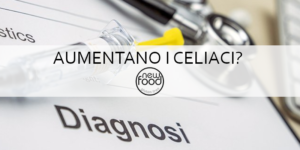In our country there is an increase in new diagnoses of celiac disease. The growing trend is indicated in the annual report on celiac disease of the Ministry of Health, presented to Parliament on 4 March 2021. The report was produced in collaboration between health institutions, trade associations and companies. Celiac disease is confirmed as a disease with a female prevalence (70% of diagnoses) and with a higher number of known cases in the juvenile and adult age groups. In absolute numbers in 2019, diagnosed celiacs reached the number of 225,418 (158,107 females and 67,311 males).
The data for the three-year period 2017-19 show a growing trend of the disease in our country, with an increase of more than 11 thousand new cases in 2019 compared to the 7600 new cases in 2018, the annual average of new diagnoses of celiac disease is around 9000 cases. These numbers can be read in an article from April 2021, published on the medicoepaziente.it website. The age distribution shows that the majority of new diagnoses are in the range between 18 and 59 years (149,439 cases), followed by people aged ≥60 years (23,148 cases). As regards the regional distribution, the highest number of celiacs compared to the population is recorded in the Autonomous Province of Trento (0.47%), followed, with similar percentages, by Valle D'Aosta and Tuscany (0.46%). In absolute numbers, the region with the most celiacs is Lombardy (40,317) followed by Campania (22,320) and Lazio (22,157).
The article also states that "public spending to support the purchase of gluten-free foods, despite the growth in the population of recognized celiacs, shows a decline in 2019, thanks to rationalization measures. In 2019, according to the Report, 221,335,652 euros were spent, with an average per capita contribution of approximately 1,000 euros. Spending was reduced by 32 million compared to 2018, due to the effect of the introduction of spending caps, which however, as reported in the Report: "did not lead to any welfare limitations or penalties for celiacs who maintained their same purchasing power as in the past.” Since 2017, celiac disease and dermatitis herpetiformis have been included among the chronic disabling diseases covered by the LEAs (Essential Levels of Assistance). For these pathologies, there is an exemption regime for health services following diagnosis and economic support for the purchase of basic gluten-free foods (e.g. bread, pasta, biscuits, pizza, cereals and more).
To support celiac patients in purchasing specifically formulated gluten-free products, the NHS guarantees a monthly financial contribution, which varies depending on the age and sex of the subject, because it takes into account the corresponding energy needs. The report reminds us that after diagnosis, a celiac patient must follow a varied and balanced gluten-free diet for life with a daily energy intake from carbohydrates of at least 55%. 20% of this intake must come from naturally gluten-free foods (e.g. foods based on rice, corn, potatoes, etc.) and the remaining 35% from specifically formulated gluten-free foods”.

Find out more more:
https://medicoepaziente.it/2021/celiachia-in-italia-nuove-diagnosi-in-aiuto/
Take a look at our online shopping: | ||111sepoarta.info/shop/


Recent Comments